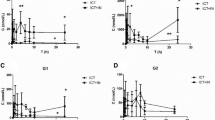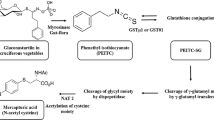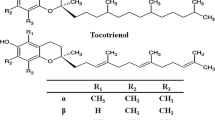Abstract
Kaempferol is a well-known flavonoid; however, it lacks extensive pharmacokinetic studies. Phase II metabolic enzymes and efflux transporters play an important role in the disposition of flavonoids. This study aimed to investigate the mechanism by which phase II metabolic enzymes and efflux transporters determine the in vivo exposure of kaempferol. Pharmacokinetic analysis in Sprague–Dawley rats revealed that kaempferol was mostly biotransformed to conjugates, namely, kaempferol-3-glucuronide (K-3-G), kaempferol-7-glucuronide (K-7-G), and kaempferol-7-sulfate, in plasma. K-3-G represented the major metabolite. Compared with that in wild-type mice, pharmacokinetics in knockout FVB mice demonstrated that the absence of multidrug resistance protein 2 (MRP2) and breast cancer resistance protein (BCRP) significantly increased the area under the curve (AUC) of the conjugates. The lack of MRP1 resulted in a much lower AUC of the conjugates. Intestinal perfusion in rats revealed that the glucuronide conjugates were mainly excreted in the small intestine, but 7-sulfate was mainly excreted in the colon. In Caco-2 monolayers, K-7-G efflux toward the apical (AP) side was significantly higher than K-3-G efflux. In contrast, K-3-G efflux toward the basolateral (BL) side was significantly higher than K-7-G efflux. The BL-to-AP efflux was significantly reduced in the presence of the MRP2 inhibitor LTC4. The AP-to-BL efflux was significantly decreased in the presence of the BL-side MRPs inhibitor MK571. The BCRP inhibitor Ko143 decreased the glucuronide conjugate efflux. Therefore, kaempferol is mainly exposed as K-3-G in vivo, which is driven by phase II metabolic enzymes and efflux transporters (i.e., BCRP and MRPs).








Similar content being viewed by others
References
Liu RH. Health-promoting components of fruits and vegetables in the diet. Adv Nutr. 2013;4(3):384S–92.
Ravishankar D, Rajora AK, Greco F, Osborn HM. Flavonoids as prospective compounds for anti-cancer therapy. Int J Biochem Cell Biol. 2013;45(12):2821–31.
Calderon-Montano JM, Burgos-Moron E, Perez-Guerrero C, Lopez-Lazaro M. A review on the dietary flavonoid kaempferol. Mini Rev Med Chem. 2011;11(4):298–344.
Nothlings U, Murphy SP, Wilkens LR, Henderson BE, Kolonel LN. Flavonols and pancreatic cancer risk: the multiethnic cohort study. Am J Epidemiol. 2007;166(8):924–31.
Wang L, Tu YC, Lian TW, Hung JT, Yen JH, Wu MJ. Distinctive antioxidant and antiinflammatory effects of flavonols. J Agric Food Chem. 2006;54(26):9798–804.
Heijnen CG, Haenen GR, van Acker FA, van der Vijgh WJ, Bast A. Flavonoids as peroxynitrite scavengers: the role of the hydroxyl groups. Toxicol in Vitro. 2001;15(1):3–6.
Kong L, Luo C, Li X, Zhou Y, He H. The anti-inflammatory effect of kaempferol on early atherosclerosis in high cholesterol fed rabbits. Lipids Health Dis. 2013;12:115.
Rajendran P, Rengarajan T, Nandakumar N, Palaniswami R, Nishigaki Y, Nishigaki I. Kaempferol, a potential cytostatic and cure for inflammatory disorders. Eur J Med Chem. 2014;86:103–12.
Dang Q, Song W, Xu D, Ma Y, Li F, Zeng J, et al. Kaempferol suppresses bladder cancer tumor growth by inhibiting cell proliferation and inducing apoptosis. Mol Carcinog. 2015;54(9):831–40.
Lee HS, Cho HJ, Yu R, Lee KW, Chun HS, Park JH. Mechanisms underlying apoptosis-inducing effects of Kaempferol in HT-29 human colon cancer cells. Int J Mol Sci. 2014;15(2):2722–37.
Yao K, Chen H, Liu K, Langfald A, Yang G, Zhang Y, et al. Kaempferol targets RSK2 and MSK1 to suppress UV radiation-induced skin cancer. Cancer Prev Res (Phila). 2014;7(9):958–67.
Cui Y, Morgenstern H, Greenland S, Tashkin DP, Mao JT, Cai L, et al. Dietary flavonoid intake and lung cancer—A population-based case–control study. Cancer-Am Cancer Soc. 2008;112(10):2241–8.
Gates MA, Tworoger SS, Hecht JL, De Vivo I, Rosner B, Hankinson SE. A prospective study of dietary flavonoid intake and incidence of epithelial ovarian cancer. Int J Cancer. 2007;121(10):2225–32.
Bobe G, Sansbury LB, Albert PS, Cross AJ, Kahle L, Ashby J, et al. Dietary flavonoids and colorectal adenoma recurrence in the Polyp Prevention Trial. Cancer Epidemiol Biomarkers Prev. 2008;17(6):1344–53.
Chen AY, Chen YC. A review of the dietary flavonoid, kaempferol on human health and cancer chemoprevention. Food Chem. 2013;138(4):2099–107.
Chen Z, Zheng S, Li L, Jiang H. Metabolism of flavonoids in human: a comprehensive review. Curr Drug Metab. 2014;15(1):48–61.
Chen J, Lin H, Hu M. Metabolism of flavonoids via enteric recycling: role of intestinal disposition. J Pharmacol Exp Ther. 2003;304(3):1228–35.
Ma Y, Zeng M, Sun R, Hu M. Disposition of flavonoids impacts their efficacy and safety. Curr Drug Metab. 2014;15(9):841–64.
Silva ID, Rodrigues AS, Gaspar J, Maia R, Laires A, Rueff J. Involvement of rat cytochrome 1A1 in the biotransformation of kaempferol to quercetin: relevance to the genotoxicity of kaempferol. Mutagenesis. 1997;12(5):383–90.
Barve A, Chen C, Hebbar V, Desiderio J, Saw CL, Kong AN. Metabolism, oral bioavailability and pharmacokinetics of chemopreventive kaempferol in rats. Biopharm Drug Dispos. 2009;30(7):356–65.
Yodogawa S, Arakawa T, Sugihara N, Furuno K. Glucurono- and sulfo-conjugation of kaempferol in rat liver subcellular preparations and cultured hepatocytes. Biol Pharm Bull. 2003;26(8):1120–4.
Romiti N, Tramonti G, Donati A, Chieli E. Effects of grapefruit juice on the multidrug transporter P-glycoprotein in the human proximal tubular cell line HK-2. Life Sci. 2004;76(3):293–302.
Wang Y, Cao J, Zeng S. Involvement of P-glycoprotein in regulating cellular levels of ginkgo flavonols: quercetin, kaempferol, and isorhamnetin. J Pharm Pharmacol. 2005;57(6):751–8.
An G, Gallegos J, Morris ME. The bioflavonoid kaempferol is an abcg2 substrate and inhibits Abcg2-mediated quercetin efflux. Drug Metab Dispos. 2011;39(3):426–32.
Limtrakul P, Khantamat O, Pintha K. Inhibition of P-glycoprotein function and expression by kaempferol and quercetin. J Chemother. 2005;17(1):86–95.
Barrington R, Williamson G, Bennett RN, Davis BD, Brodbelt JS, Kroon PA. Absorption, conjugation and efflux of the flavonoids, kaempferol and galangin, using the intestinal CaCo-2/TC7 cell model. J Funct Foods. 2009;1(1):74–87.
Zhang W, Wang X, Zhou S, Gu Y, Wang R, Zhang T, et al. Determination of free and glucuronidated kaempferol in rat plasma by LC-MS/MS: application to pharmacokinetic study. J Chromatogr B. 2010;878(23):2137–40.
Shi J, Zheng L, Lin Z, Hou C, Liu W, Yan T, et al. Study of pharmacokinetic profiles and characteristics of active components and their metabolites in rat plasma following oral administration of the water extract of Astragali radix using UPLC-MS/MS. J Ethnopharmacol. 2015;169:183–94.
Dai P, Zhu L, Luo F, Lu L, Li Q, Wang L, et al. Triple recycling processes impact systemic and local bioavailability of orally administered flavonoids. AAPS J. 2015;17(3):723–36.
Zhu W, Xu H, Wang SWJ, Hu M. Breast cancer resistance protein (BCRP) and sulfotransferases contribute significantly to the disposition of genistein in mouse intestine. AAPS J. 2010;12(4):525–36.
Ye L, Lu L, Li Y, Zeng S, Yang X, Chen W, et al. Potential role of ATP-binding cassette transporters in the intestinal transport of rhein. Food Chem Toxicol. 2013;58:301–5.
Liu W, Feng Q, Li Y, Ye L, Hu M, Liu Z. Coupling of UDP-glucuronosyltransferases and multidrug resistance-associated proteins is responsible for the intestinal disposition and poor bioavailability of emodin. Toxicol Appl Pharmacol. 2012;265(3):316–24.
Dai P, Zhu L, Yang X, Zhao M, Shi J, Wang Y, et al. Multidrug resistance-associated protein 2 is involved in the efflux of Aconitum alkaloids determined by MRP2-MDCKII cells. Life Sci. 2015;127:66–72.
Singh R, Wu B, Tang L, Liu Z, Hu M. Identification of the position of mono-O-glucuronide of flavones and flavonols by analyzing shift in online UV spectrum (λmax) generated from an online diode array detector. J Agric Food Chem. 2010;58(17):9384–95.
Tang L, Zhou J, Yang C, Xia B, Hu M, Liu Z. Systematic studies of sulfation and glucuronidation of 12 flavonoids in the mouse liver S9 fraction reveal both unique and shared positional preferences. J Agric Food Chem. 2012;60(12):3223–33.
Enokizono J, Kusuhara H, Sugiyama Y. Regional expression and activity of breast cancer resistance protein (Bcrp/Abcg2) in mouse intestine: Overlapping distribution with sulfotransferases. Drug Metab Dispos. 2007;35(6):922–8.
Cherrington NJ, Hartley DP, Li N, Johnson DR, Klaassen CD. Organ distribution of multidrug resistance proteins 1, 2, and 3 (Mrp1, 2, and 3) mRNA and hepatic induction of Mrp3 by constitutive androstane receptor activators in rats. J Pharmacol Exp Ther. 2002;300(1):97–104.
Yang Z, Zhu W, Gao S, Yin T, Jiang W, Hu M. Breast cancer resistance protein (ABCG2) determines distribution of genistein phase II metabolites: reevaluation of the roles of ABCG2 in the disposition of genistein. Drug Metab Dispos. 2012;40(10):1883–93.
Acknowledgments
This work was supported by the grants of National Natural Science Foundation of China (81120108025 and 81503466), Science and Technology Project of Guangzhou City (201509010004) and Guangdong Natural Science Foundation Province (2015AD030312012).
Author information
Authors and Affiliations
Corresponding authors
Additional information
Liang Zheng and Lijun Zhu contributed equally to this work.
Rights and permissions
About this article
Cite this article
Zheng, L., Zhu, L., Zhao, M. et al. In Vivo Exposure of Kaempferol Is Driven by Phase II Metabolic Enzymes and Efflux Transporters. AAPS J 18, 1289–1299 (2016). https://doi.org/10.1208/s12248-016-9951-9
Received:
Accepted:
Published:
Issue Date:
DOI: https://doi.org/10.1208/s12248-016-9951-9




